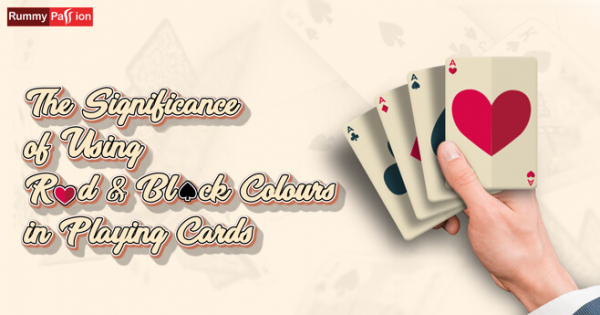
The Significance Of Using Red & Black Colours In Playing Cards
Playing cards have known to exist since the 9th century, although at the time, leaves were used in place of the cards we know today. Playing cards have evolved a lot over time, leading to the evolution of many interesting, skill-based card games such as Rummy. But playing cards were not always the same as we know them today. Just like the card games, a standard went through many design and colour changes over time. You must have played with the cards many a time in your life, but did you ever ponder over the fact that why only red & black colours are used in printing cards? Here’s why playing cards nowadays are only printed in the standard red and black colours.
A Glimpse into the History of Playing Cards
There is no doubt that the concept of playing a game of cards evolved in the Tang Dynasty, back in the 9th century. Princess Tongchang was first seen playing the ‘leaf game’ with her husband’s family in 868, as recorded by writer Su E. Gradually, wooden blocks and then paper replaced the leaves, finally evolving to the plastic-based paper cards that we know of today. With time, many changes were also made in the number of cards forming part of a deck, the suit colours, designs, game rules etc. By the 11th century, playing cards became a famous sport in Asia and gradually were introduced in Egypt. The Arabs introduced them to Europe in the 1300s from where their popularity spread throughout the world. A significant number of design changes were made by different European nations, owing to the different cultures. Of these, the cards developed by the French became highly popular.
With time, the use of French-suited playing cards became more predominant, leading to the popularity of cards as we know them today. It is the result of French influence that we have 13 cards each of Spades ♠, Diamonds♦, Clubs ♣ and Hearts ♥, printed in just the standard red and black colour. But are you aware that there was a time when a standard deck was printed in four colours, green and blue being the other two?
The Four-Coloured Deck
There was once a time when four-coloured decks of cards were trendy. These were initially introduced to help minimise confusion amongst players, preventing them from discarding/picking up Spades instead of Clubs (both being black) or Diamonds in place of Hearts (both red in colour). For this reason, they were more commonly known as the no-revoke decks. These were mostly used in trick-based games such as bridge, ass and whist, massively manufactured during the 1900s.
The earliest 4-coloured deck was created by JY Humphreys in the US in 1819, with yellow diamonds, blue spades, green clubs and red hearts. With time, many different variations of these colours were used, some cards having the standard Clubs ♣ in black and Hearts ♥ in red, with the remaining two suits in blue and green colours.
Why Red and Black Coloured Cards Are More Prominent Nowadays?
Despite the wide popularity of four-coloured decks, it is only the red and black colours that stayed. The primary reason for this being that both these colours were cheap to manufacture and clearly stood out on the cards even at a distance. The black ink was made by mixing linseed oil and soot, whereas the former was mixed with cinnabar to make the colour red. Both these inks proved to be durable, rarely fading away even when exposed to sunlight. Some theories even state red and black to be a symbolism of day and night.
Regardless of the reasons, red and black are what stood out to date, and card manufacturers nowadays only use these two colours for every deck they produce. The uniformity of colours allows for cheaper manufacturing costs. On the other hand, using just two colours to denote four different suits poses a challenge for players in a fast-paced game, thus adding to the thrill and competition.
The Gist
No matter what colours the playing cards are available in, what matters the most is that they help keep us entertained and get closer with our family/friends. Playing skill-based card games such as online rummy also helps build new skills, providing players with an opportunity to win amazing rewards. So, if you are a rummy fanatic, now is the best time to get on the tables, take up the next challenge and play with passion for grabbing those big rewards.
Passion Se Khel!








